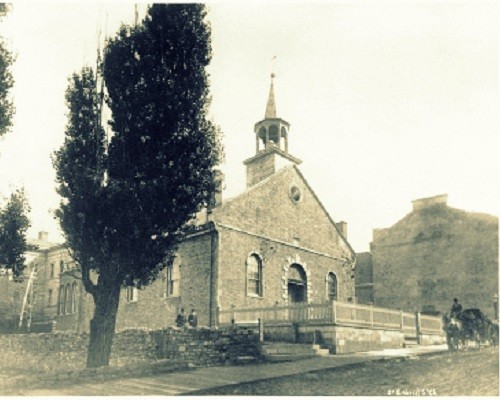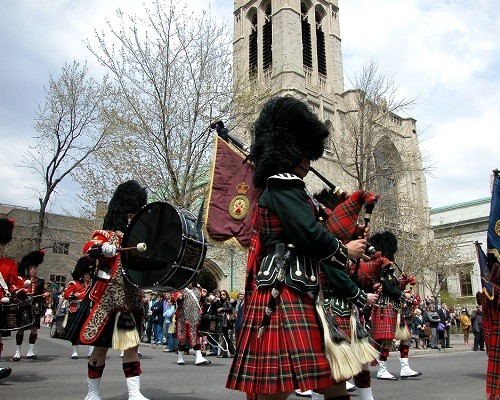Get To Know Us
More than just a magnificent building, The Church of St. Andrew and St. Paul is a vibrant hub of caring people living and sharing God’s message of hope while reaching out to those in need in their local community in Montreal, Canada and worldwide. We are members of the Presbyterian Church in Canada. We hold traditional worship services accompanied by our renowned choir singing traditional sacred music every Sunday morning at 11 a.m. EST in our spacious sanctuary. In addition to the beautiful stained glass windows, the church also has a majestic organ, one of the largest in Montreal, to accompany our choir. Special services and musical performances are held throughout the year, all open to the public. Visitors are welcome to join us in Holy Communion which is held 6 times per year. There is also a Crèche (Nursery) and Church School (Sunday School) for your children, so please bring them along.
As one of the largest and most vibrant Presbyterian Congregations in Canada, we welcome all to worship with us or join our community to participate in our projects and activities. Diversity is one of our mainstays as seen every year during our Heritage Service where we parade in over 30 flags of the different nations represented by members in the congregation. We also encourage you to join us after services for “Coffee and Fellowship” to learn more about what we are doing.
We encourage you to watch the following slideshow highlighting the past year at our church. We are blessed with such a vibrant life and active congregation that we cherish each and every day.
anchor
Mission Projects
In addition, the Church has numerous committees that undertake our many mission projects. For example, in Montreal, we help close to 20 different local charities. On the international scene, we work through the Presbyterian World, Service & Development agency that provides development and relief in challenged countries, especially Africa. Ten years ago, we welcomed a young African refugee who started a new life in Canada. Our congregation is currently sponsoring a Syrian refugee family and working with Action Réfugié Montréal and the YMCA Residence on Tupper Street in Montreal to provide help to hundreds of cross-border refugees from the US.
Our youth group brings together young people from Grade 6 through High School who are very active in the community, often helping with various events around the church and fundraising for many of our projects. Another group that we call “The Guild” organizes one of our largest events, our “Annual Fall Fair” in November where donated items and baked goods are sold to raise funds that are distributed to the many charities that depend on our support each year.
Our Building
At the front of the church are the Chancel gates, a gift of the Allan family. You will notice the ship motif, evident throughout the Nave, repeated in the brass models of the brig "Jean". This was the first Allan ship to transport Scottish immigrants to Canada. The other two emblems on the gates are a sheaf of wheat and a chalice, symbolizing the bread and wine of Holy Communion. Three steps though the ship-motif gates lead to the Chancel, dominated by the pulpit to the left, the lectern to the right and stalls for our 50-voice choir.
To your right beyond the choir stalls is the console of Montreal's largest organ, a four-manual 1932 Casavant. There is a second console in the gallery. Most of the organ is hidden from view by the grillwork on both sides of the Chancel and on the west wall of the gallery. The visible pipes overhead are the Trompette en chamade.
A total of seven steps - the Biblical number for perfection - ascend to the white stone Communion Table on which are engraved the Cross, the Paschal Lamb, the Dove of the Holy Spirit, and on either end, the Alpha and the Omega. Surrounding the Table are the Elders' Stalls in which the members of the Kirk Session sit for the celebration of Holy Communion. The stalls are surmounted by hand-carved heads whose faces express the commandment of Jesus to his followers to "watch and pray". On the ceiling you may discover the symbols of Holy Communion: the Cross, the Chalice, the Crown and the Dove. The silver cross on the Communion Table was a gift of Wayne Riddell, Director of Music Emeritus.

The Quiet Garden
Lord, thy call we answer. Take us in thy care. Train us in thy garden. In thy work to share.
Between the church and the Musée des beaux arts to the east, is the Quiet Garden, a bicentennial project that opened in 2003. It provides a haven for reflection in this busy downtown neighbourhood. During the summer, it is often the site for Bible Study and post-service receptions. The entrance off Sherbrooke Street is open seasonally from 9 a.m. to 4 p.m. EST. Our Quiet Garden is a spiritual oasis in the city; a place for busy people to find a quiet interlude for prayer and meditation. Everyone is welcome to enter into this beautiful and secure space. It is filled with life and growth and colour, reminders of God's reassuring work in our world. We hope that in our garden, visitors, friends and neighbours will find solace, serenity and the radiant presence of our risen Lord, who first came to his followers in a garden.
Our History
Tradition and Change...
The first Presbyterian service in Montreal was held in 1787. In 1803, when the city's population was about 9,000, St. Andrew's Church was founded near the present site of city hall on Notre Dame Street. St. Paul's Church was opened nearby in 1843. In 1853, as Montreal grew, St. Andrew's built a new church on Beaver Hall Hill (on the present site of a Bell Canada building). In 1867, St. Paul's Church also decided to move and they built on a site on Dorchester Boulevard, (now boulevard René Lévesque) near today’s Queen Elizabeth Hotel. By 1918, the two congregations decided to unite and the present building was erected in 1931-32. The former St. Paul's church was dismantled and reconstructed just south of the present site of Vanier College in Ville St-Laurent, where it now serves as a museum.
As part of our church's bicentennial in 2003, The Rev. Dr. J.S.S. Armour published Saints, Sinners and Scots, a history of our congregation. It is available at the Book Stall in the Narthex.


The Black Watch
On the first Sunday each May, The Black Watch of Canada (Royal Highland Regiment) marches in its annual Church Parade along Sherbrooke Street from the Bleury Street Armoury to The Church of St. Andrew and St. Paul and back again. All are welcome to share this testament to peace.
This historic regiment has a long association with our church. Their presence honours the many members of our congregation who have given their lives in our defence. Their names are inscribed on our walls. The Colours (flags) of the Regiment hang in our Sanctuary to represent their sacrifice in defending the peace we cherish and our freedom to worship in liberty.
You can also see other instances of symbolism in the Church Parade. Soldiers march to the church - the army comes humbly to God's house. They lay down their Colours, which are a record of history, on the Lord's Table and worship in peace. The Commanding Officer reads the Lesson, acknowledgement of the dominion of God's word. The haunting bagpipe lament during the service mourns those who have died in honour, its sound fading as a reminder to never forget their sacrifice. The Sermon by the Regiment's Chaplain reminds us of the supremacy of Christ's message to the world. As the service ends, the regiment carries its Colours, furled as they depart from the Sanctuary, ready once again - as in our national anthem's call to duty - to stand on guard for us.
You will find more information about The Black Watch at their website.
Ministers, Staff and Collaborators
Music Staff
Director of Music & Choir Manager
Leading with Care
A Policy for Ensuring a Climate of Safety for Children, Youth and Vulnerable Adults in the Presbyterian Church in Canada.
We are committed to providing safe and compassionate environments for all people, in particular all children, youth, and vulnerable adults who participate in the church's programs and ministries and/or use the church's facilities.
THIS POLICY IS TITLED LEADING WITH CARE BECAUSE:
Our Lord modeled for us how to lead with care as he healed the sick and infirm, and welcomed the young, the weak, and the vulnerable.
It is our awareness that some people in our church need special protection.
It affirms our commitment to training and supporting teachers and leaders in our church so they can effectively and compassionately support this policy.

